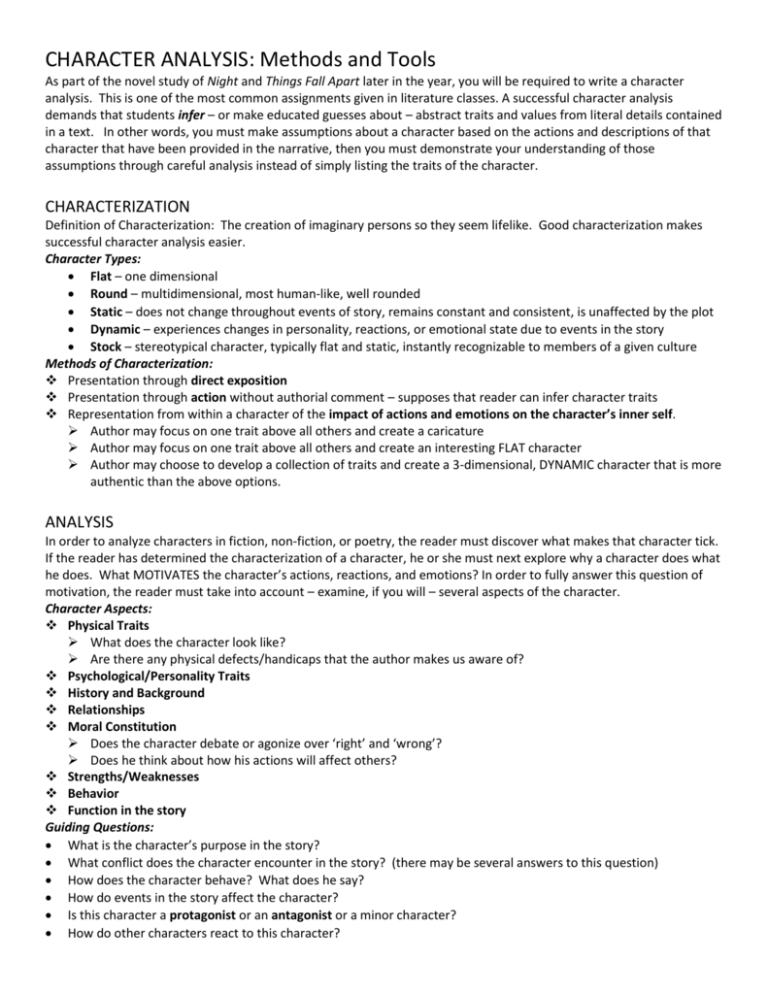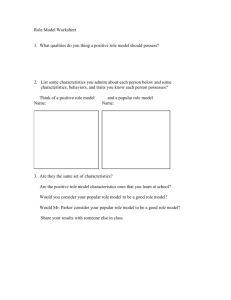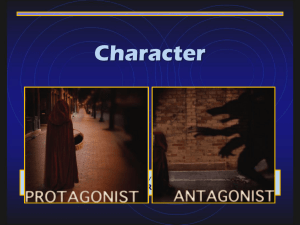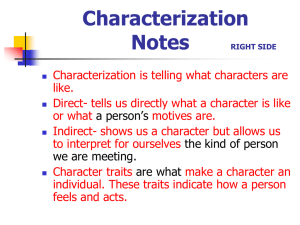Character Analysis Wkst
advertisement

CHARACTER ANALYSIS: Methods and Tools As part of the novel study of Night and Things Fall Apart later in the year, you will be required to write a character analysis. This is one of the most common assignments given in literature classes. A successful character analysis demands that students infer – or make educated guesses about – abstract traits and values from literal details contained in a text. In other words, you must make assumptions about a character based on the actions and descriptions of that character that have been provided in the narrative, then you must demonstrate your understanding of those assumptions through careful analysis instead of simply listing the traits of the character. CHARACTERIZATION Definition of Characterization: The creation of imaginary persons so they seem lifelike. Good characterization makes successful character analysis easier. Character Types: Flat – one dimensional Round – multidimensional, most human-like, well rounded Static – does not change throughout events of story, remains constant and consistent, is unaffected by the plot Dynamic – experiences changes in personality, reactions, or emotional state due to events in the story Stock – stereotypical character, typically flat and static, instantly recognizable to members of a given culture Methods of Characterization: Presentation through direct exposition Presentation through action without authorial comment – supposes that reader can infer character traits Representation from within a character of the impact of actions and emotions on the character’s inner self. Author may focus on one trait above all others and create a caricature Author may focus on one trait above all others and create an interesting FLAT character Author may choose to develop a collection of traits and create a 3-dimensional, DYNAMIC character that is more authentic than the above options. ANALYSIS In order to analyze characters in fiction, non-fiction, or poetry, the reader must discover what makes that character tick. If the reader has determined the characterization of a character, he or she must next explore why a character does what he does. What MOTIVATES the character’s actions, reactions, and emotions? In order to fully answer this question of motivation, the reader must take into account – examine, if you will – several aspects of the character. Character Aspects: Physical Traits What does the character look like? Are there any physical defects/handicaps that the author makes us aware of? Psychological/Personality Traits History and Background Relationships Moral Constitution Does the character debate or agonize over ‘right’ and ‘wrong’? Does he think about how his actions will affect others? Strengths/Weaknesses Behavior Function in the story Guiding Questions: What is the character’s purpose in the story? What conflict does the character encounter in the story? (there may be several answers to this question) How does the character behave? What does he say? How do events in the story affect the character? Is this character a protagonist or an antagonist or a minor character? How do other characters react to this character? Character Analysis Worksheet The following questions are designed to help you analyze your character. They will help you gather information about your character, as well as your reactions to that character, so that you may write a successful formal character analysis. 1. Character Name:__________________________ Character Type:_________________________ 2. How is the character presented to us? How are we introduced to him/her? __________________________________ _________________________________________________________________________________________________ _________________________________________________________________________________________________ 3. What physical traits does the author give the character? _________________________________________________ _________________________________________________________________________________________________ _________________________________________________________________________________________________ 4. How do those traits affect the author, if at all? _________________________________________________________ _________________________________________________________________________________________________ _________________________________________________________________________________________________ 5. In what ways has society or the environment created the character? _______________________________________ _________________________________________________________________________________________________ _________________________________________________________________________________________________ _________________________________________________________________________________________________ 6. How does the character react to specific events in the story? (choose an event and give the character’s reaction) _________________________________________________________________________________________________ _________________________________________________________________________________________________ _________________________________________________________________________________________________ _________________________________________________________________________________________________ 7. How do other characters in the story react to your character?_____________________________________________ _________________________________________________________________________________________________ _________________________________________________________________________________________________ 8. Is the character self aware? Does the character KNOW why he or she reacts as s/he does? _____________________ What evidence from the story makes you sure the character is self aware? ____________________________________ _________________________________________________________________________________________________ _________________________________________________________________________________________________ 9. How does the character view his world? ______________________________________________________________ _________________________________________________________________________________________________ _________________________________________________________________________________________________ Is this view realistic? Why or why not? __________________________________________________________________ _________________________________________________________________________________________________ _________________________________________________________________________________________________ 10. Would a person in real life behave or feel the way the character does? Why or why not? _____________________ _________________________________________________________________________________________________ _________________________________________________________________________________________________ _________________________________________________________________________________________________ Once you have filled out this worksheet, you will have the information needed to write the character analysis essay.









